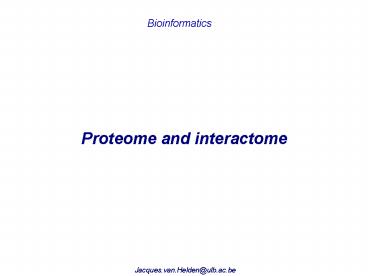Proteome and interactome
1 / 24
Title:
Proteome and interactome
Description:
Ito et al. (2001) PNAS 98: 4569-4574. Uetz et al. (2000). Nature 403: 623-631 ... Gavin et al. (1999). Nature 415: 141-147. Network of complexes. Gavin et al. (1999) ... –
Number of Views:271
Avg rating:3.0/5.0
Title: Proteome and interactome
1
Proteome and interactome
- Bioinformatics
2
Contents
- Protein-protein interactions
- Two-hybrid assays
- Mass spectrometry
- Cellular localization of proteins
- GFP tags
- Protein-DNA interactions
- ChIP-on-chip
3
Two-hybrid assays
- Functional genomics
4
Two-hybrid method
Transcription factor
Hybrid constructions
Bait
Prey
Interaction ? reporter gene is expressed
No interaction ? reporter gene is not expressed
Prey
Prey
Bait
Bait
5
Two-hybrid
Uetz et al. (2000). Nature 403 623-631
Ito et al. (2001) PNAS 98 4569-4574
6
Comparison of the results
- When the second comprehensive analysis was
published, the overlap between thee results
obtained in the two independent studies was
surprisingly low. - How to interpret this ?
- Problem of coverage ? Each study would only
represent a fraction of what remains to be
discovered. - Problem of noise ? Either or both studies might
contain a large number of false positives. - Differences in experimental conditions ?
7
Connectivity in protein interaction networks
- Jeong et al (2001) calculate connectivity in the
protein interaction network revealed by the
two-hybrid analysis of Uetz and co-workers. - The connectivity follows a power law
- most proteins have a few connections
- a few proteins are highly connected
- Highly connected proteins correspond to essential
proteins.
Jeong, H., S.P. Mason, A.L. Barabasi, and Z.N.
Oltvai. 2001. Lethality and centrality in
protein networks. Nature 411 41-42.
8
Mass-spectrometry
- Functional genomics
9
Isolation of protein complexes
1. Construction of a bank of TAG-fused ORFs
2. Expression of the tagged baits in yeast
tagged bait
All cellular proteins,
3. Cell lysis
4. Affinity purification
anti-tag epitope
Other proteins,
Slide from Nicolas Simonis
10
Mass spectrometry - Protein identification
1 dimension SDS-PAGE
isolation
Mass spectrometry
B
YLR258w YER133w YER054c
A
YPR184w YKL085w YPR160w
C
D
E
Y
Slide from Nicolas Simonis
11
Protein complexes
Gavin et al. (1999). Nature 415 141-147
Tandem Affinity Purification (TAP) CELLZOME 232
complexes
Ho et al. (1999). Nature 415 180-183
High-throughput mass-spectrometric protein
complex identification (HMS-PCI) MDS
proteomics 493 complexes
12
Network of complexes
Gavin et al. (1999). Nature 415 141-147
13
Assessment of interactome data
- Functional genomics
14
Assessment of interactome data
von Mering et al (2002). Nature.
15
Comparison of large-scale interaction data
- von Mering et al (2002) compared the results from
- Two-hybrid assays
- Mass spectrometry (TAP and HMS-PCI)
- Co-expression in microarray experiments
- Synthetic lethality
- Comparative genomics (conservation of operons,
phylogenetic profiles, and gene fusion) - Among 80,000 interactions, no more than 2,400 are
supported by two different methods. - Each method is more specifically related to some
- functional classes
- cellular location
Reference von Mering et al. (2002). Nature 750
16
Comparison of pairs of interacting proteins with
functional classes
von Mering et al (2002). Nature 750.
17
Validation with annotated complexes
- von Mering et al (2002) collected information on
experimentally proven physical protein-protein
interactions, and measured the coverage and
positive predictive value of each predictive
method - Coverage
- fraction of reference set covered by the data.
- Positive predictive value
- Fraction of data confirmed by reference set.
- (Note they call this accuracy, but this term
is usually not used in this way) - Beware the scale is logarithmic !
- This enforces the differences in the lower part
of the percentages (0-10), but compresses the
values between 10 and 50, which gives a false
impression of good accuracy.
von Mering et al (2002). Nature.
18
Cellular localization of proteins
- Bioinformatics
19
Nature (2003) 425 686-691
4156 proteins detected by fluorescence
microscopy analysis
Slide adapted from Bruno André
20
Global analysis of protein localization
- This analysis allowed to obtain information for
thousands of proteins for which the cellular
localization was previously unknown.
Slide adapted from Bruno André
21
Localisation and ORF function
- For historical reasons, the yeast genome is
over-annotated. - The method used for predicting genes from genome
sequences included many false positives,
especially among short predicted ORFs. - Most of the questionable ORFs were unobserved in
the global localization analysis. These mainly
correspond to short ORFs.
Source Bruno André
22
Protein-DNA interactionsChIP-on-chip technology
- Functional genomics
23
The ChIP-on-chip method
- Chromatin Immuno-precipitation (ChIP)
- Tagging of a transcription factor of interest
with a protein fragment recognized by some
antibody. - Immobilization of protein-DNA interactions with a
fixative agent. - DNA fragmentation by ultrasonication.
- Precipitation of the DNA-protein complexes.
- Un-binding of the DNA-protein bounds.
- Measurement of DNA enrichment.
- Two extracts are co-hybridized on a microarray
(chip),where each spot contains one DNA fragment
where a factor is likely to bind (e.g. an
intergenic region, or a smaller fragment).. - For the yeast S.cerevisiae, chips have been
designed with all the intergenic regions (6000
regions, avg. 500bp/region) - Recent technology allows to spot 3e5 300bp DNA
fragments on a single slide. - The first extract (labelled in red) is enriched
in DNA fragments bound to the tagged
transcription factor. - The second extract (labelled in green) has not
been enriched. - The log-ratio between red and green channels
indicate the enrichment for each intergenic
region.
24
Lee et al (2002)
- In 2002, Lee et al publish a systematic
characterization of the binding regions of 106
yeast transcription factors.
Lee et al. 2002. Science 298 799-804.































